
Whether your swimming pool is brand-new or a few years (or even decades) old, it is a prime spot for a surrounding garden filled with beautiful trees, shrubs, and flowers. Use these tips and plant suggestions as you install or revitalize your pool landscaping.
Interested in adding a water garden to complement your pool? Find plants, plans, and inspiration.
continue reading below
Include Shade
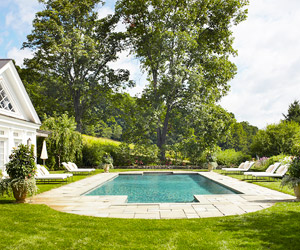
Relief from the sun, usually with trees, is an almost must-have when it comes to pool landscaping. The one tree trait you want to avoid, says Catriona Tudor Erler, author of Poolscaping (Storey Publishing, 2003), is a towering plant that sheds a lot. “Trees that are less likely to shed will make pool maintenance easier,” Tudor Erler says. If the tree does shed, place it so that branches won’t grow to hang over the pool’s edge. In warmer climates, a good choice is a palm tree, which sheds little and has a small root ball.
Although pool landscaping should include some shade either nearby on the pool’s pad or at one end of the water, trees should have less-aggressive root systems, Tudor Erler says, to avoid uprooting any hardscaping.
Plant in Pockets
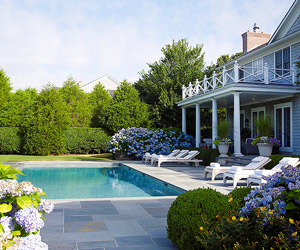
Starting pool landscaping from scratch certainly has its advantages. But that doesn’t mean you can’t redo an old pool landscape using the same plant suggestions and tips. As a key element, Tudor Erler relies on including a small planting pocket garden right next to the pool — a little corner or small bed to offer color and provide visual relief.
Try a tidy ornamental grass such as feather reedgrass, which can reach 4 feet and has flowering stems in late spring or early summer.
If your pool landscaping features a more natural appearance with surrounding rocks or irregular pavers, it’s good to fill the in-between hardscape spaces with plants that soften, grow low, and spread, such as groundcovers.
Containers are a blue-ribbon choice to dress up pool landscaping, particularly if you lack the budget, time, or desire to change your permanent landscape. The one caveat: Tudor Erler recommends containers that match the scale of your pool.
Add Height
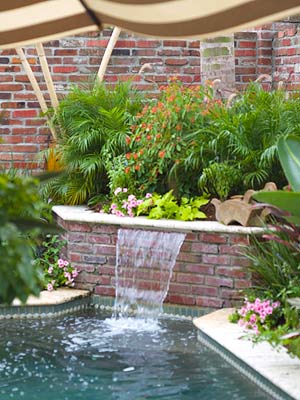
Because pools — even if they are elevated slightly — are so strongly horizontal, it’s helpful to add a big raised bed next to the pool, Tudor Erler says. “The planting beds don’t have to be right up against the pool,” she says, since shedding blooms and foliage can add to pool maintenance. “A well-done pool landscaping will have all kinds of floral interest, drama, and height.”
Raised beds aren’t the only addition that can add vertical height to a swimming pool landscape; containers filled with dwarf trees or shrubs can provide height, too. “Another idea is to stack containers in diminishing height and fill with cascading plants,” Tudor Erler says.
Try a dwarf variety of burning bush, a deciduous shrub with leaves that turn red in autumn.
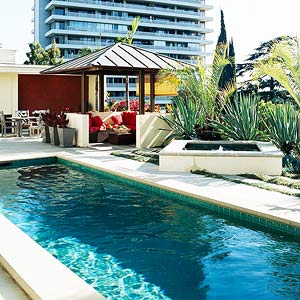
Pool landscaping also should include structures such as pergolas and trellises. “They’ll provide shade and vertical interest,” Tudor Erler says. “If you’ve got a neighbor, a pergola along a fence gives you extra height and privacy.”
Place containers planted with climbing vines at the base of a pergola. A good plant choice is wisteria, a deciduous, fragrant climber that blooms in white, blue, purple, lavender, or pink. The vines will soften the hardscape and lead the eye upward.
Furniture can also be a pleasing complement your pool landscaping, Tudor Erler says. Include outdoor rugs in your furniture arrangement to delineate living spaces (and cover up some of the pool’s pad, too).
Landscape Your Pool So Bees Stay Away
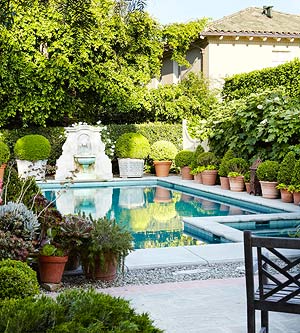
Bees are typically a much-desired visitor to the garden, but around a pool, a swarm of the insects can make children — and parents — nervous. “If you leave bees alone, they’ll leave you alone,” Tudor Erler says. “And not all flowers attract bees.”
Dwarf evergreen shrubs in containers make a particularly fine choice because they don’t spread and have a tidy habit — plus varieties come in a wide range of colors. Ornamental grasses and other foliage plants are also top choices because they don’t offer blooms to attract bees. Before you select a flowering plant, check it out to ensure it is not a favorite of bees.